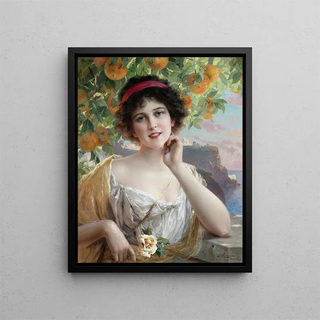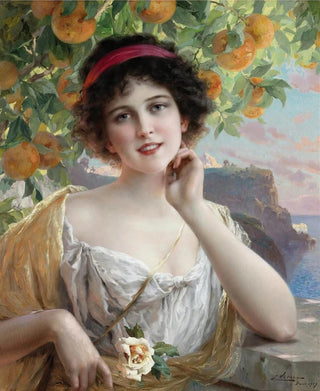Art print | The beauty under the orange tree - Émile Vernon


View from behind

Frame (optional)
In the fascinating world of art, some works stand out for their ability to capture the very essence of beauty. "The Beauty Under the Orange Tree" by Émile Vernon is one of those creations that, through its elegance and delicacy, transports us to a universe where nature and humanity intertwine harmoniously. This piece, created in the early 20th century, embodies an era when art reflected the aesthetic aspirations of a society in full transformation. Contemplating this work invites the viewer to explore a sensory world, where light, color, and form come together to create an atmosphere filled with serenity.
Style and uniqueness of the work
Émile Vernon's style is distinguished by its finesse and sensitivity. "The Beauty Under the Orange Tree" perfectly illustrates his unique approach, blending realism with a touch of Impressionism. Pastel colors, delicate and luminous, are applied with a lightness that evokes the softness of a sunny afternoon. The female figure, delicately draped, almost seems to float within this vegetal setting, where the orange tree branches add a touch of freshness and vitality. The composition is carefully balanced, with each element having its place, contributing to a visual harmony that captivates the eye. Vernon's mastery of playing with light, creating soft shadows and subtle reflections, testifies to his immense talent and deep understanding of natural effects.
The artist and his influence
Émile Vernon, a French artist of the early 20th century, is often associated with the Nabis movement, a group of artists advocating a symbolic and decorative approach to art. His work is characterized by a constant pursuit of beauty and harmony, influenced by the artistic currents of his time. Vernon established himself as a master of color and light, essential elements that run through all his creations. His ability to incorporate floral motifs and landscapes into his compositions reflects his love for nature and his desire to celebrate femininity. Exploring themes of beauty and sensuality, Vernon left a lasting imprint

Matte finish

View from behind

Frame (optional)
In the fascinating world of art, some works stand out for their ability to capture the very essence of beauty. "The Beauty Under the Orange Tree" by Émile Vernon is one of those creations that, through its elegance and delicacy, transports us to a universe where nature and humanity intertwine harmoniously. This piece, created in the early 20th century, embodies an era when art reflected the aesthetic aspirations of a society in full transformation. Contemplating this work invites the viewer to explore a sensory world, where light, color, and form come together to create an atmosphere filled with serenity.
Style and uniqueness of the work
Émile Vernon's style is distinguished by its finesse and sensitivity. "The Beauty Under the Orange Tree" perfectly illustrates his unique approach, blending realism with a touch of Impressionism. Pastel colors, delicate and luminous, are applied with a lightness that evokes the softness of a sunny afternoon. The female figure, delicately draped, almost seems to float within this vegetal setting, where the orange tree branches add a touch of freshness and vitality. The composition is carefully balanced, with each element having its place, contributing to a visual harmony that captivates the eye. Vernon's mastery of playing with light, creating soft shadows and subtle reflections, testifies to his immense talent and deep understanding of natural effects.
The artist and his influence
Émile Vernon, a French artist of the early 20th century, is often associated with the Nabis movement, a group of artists advocating a symbolic and decorative approach to art. His work is characterized by a constant pursuit of beauty and harmony, influenced by the artistic currents of his time. Vernon established himself as a master of color and light, essential elements that run through all his creations. His ability to incorporate floral motifs and landscapes into his compositions reflects his love for nature and his desire to celebrate femininity. Exploring themes of beauty and sensuality, Vernon left a lasting imprint






